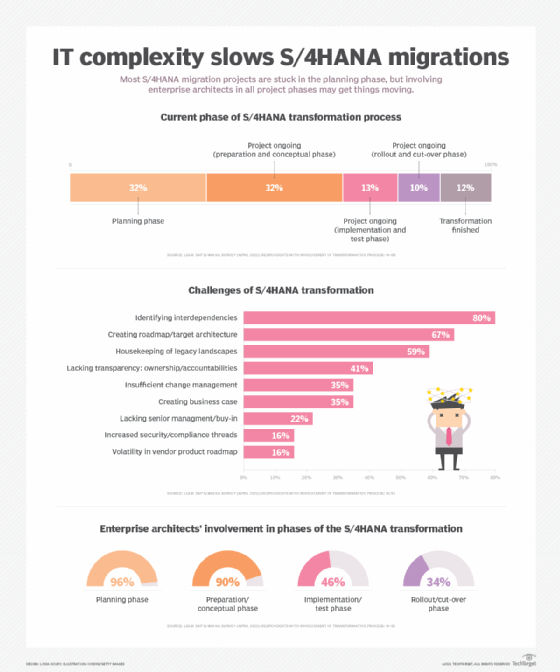
IT complexity slows S/4HANA migration pace
Most S/4HANA projects are being held up by the complexity of SAP system environments, and organizations need to fully understand the systems and align IT and business to succeed.
Most SAP customers are intent on an S/4HANA migration, but a lot of these projects remain stuck in the planning stages.
The culprit lies with the complexity of these organizations' IT landscapes, according to a new survey from LeanIX, a company based in Bonn, Germany, that provides IT infrastructure software and services for SAP and other enterprise systems.
LeanIX surveyed its customers who run SAP systems, and the results indicate that most have a long way to go before they'll complete a full S/4HANA migration.
The survey was conducted online in April 2021 and received 70 responses from SAP professionals, with about 50 who identified as enterprise architects who are or have been involved with S/4HANA migration projects.
The majority of respondents were enterprise architects in large enterprise organizations, who are tasked with planning and conducting major IT projects like an S/4HANA migration, said Christian Richter, LeanIX senior vice president of customer success.
 Christian Richter
Christian Richter
According to the survey, 32% of respondents are only in the planning phase of an S/4HANA project, while another 32% have started a project but are still in the preparation and conceptual phase. Just 12% reported that the S/4HANA transformation had been completed.
The survey results were not a surprise, according to Richter.
"From what I see with our customers, they are rather hesitant and are saying, 'Let's wait,'" he said. "Also, the launch of Rise with SAP didn't really accelerate that, so people are still waiting."
Rise with SAP is an initiative that SAP launched in January to help spur S/4HANA migrations by offering a simplified SaaS-like implementation model.
Perhaps the biggest stumbling block that's causing the hesitancy is the sheer complexity of typical SAP IT landscapes, Richter explained.
"In larger settings there are often multiple SAP instances running, through acquisitions or through organic growth," he said. "One respondent has 59 SAP systems running, and one is managing 130 SAP systems. It then becomes a huge challenge to know how many you have, what modules you have in those single instances, what's the path of consolidation for those."

Enterprise architects need to be involved in all phases
One way to help get S/4HANA projects moving and completed is to involve enterprise architects in all phases of the project, according to the report.
LeanIX provides software tools that allow customers to understand their entire IT landscape -- not just SAP systems -- including what the applications are, what their business functions are, who uses them, and the underlying technology layer, according to Richter.
The survey indicates that almost all enterprise architects who responded are involved in the planning and conceptual phases of projects, while fewer than half are involved in the implementation, testing and rollout phases.
Enterprise architects can help organizations get transparency over the entire IT landscape for the duration of an S/4HANA migration, Richter said. For example, it's important to see how application capabilities are supported in the current system and determine what capabilities are covered in S/4HANA.
"You have to look at what the landscape looks like today, what the landscape will look in two years if you follow the plan, what the landscape will look like in five years," he said. "You can determine how this will decrease your costs because you're phasing out the expensive components of today."
Need for a technical and business transformation
SAP customers need to fully understand the IT landscape and their business processes if they are going to have a successful S/4HANA migration, said Roan Low, an SAP solutions architect at Syntax Systems, a Montreal-based firm that provides managed cloud services for SAP and other enterprise systems.
 Roan Low
Roan Low
An S/4HANA migration is complex because it involves both a technical and business transformation, Low said.
"S/4HANA is not a simple migration; you can do a simple migration to S/4HANA, but you're not going to gain those benefits of going to an in-memory database by just moving your current business processes across there," he said. "This holistic business process transformation needs to occur in order to truly get the benefit of it."
Moving to an in-memory database also carries infrastructure costs, whether it's an on-premises or cloud infrastructure, Low said.
"So there are always additional costs that come from an S/4HANA database," he said. "Those are the two big reasons right now why companies are adopting a bit of a cautious approach as they move forward on their S/4HANA strategy."
S/4HANA technical upgrade not enough
Organizations need to look at a move to the cloud as a prerequisite for business transformation and not just migrate their current operating model, according to Low.
"If you truly want to take advantage of the benefits that come from a cloud operating model, you need to change your IT operating model to align with that," he said. "You can do a technical upgrade from ECC to S/4HANA, but you're not going to get the true benefit unless you adopt the S/4HANA business processes."
There also needs to be alignment between the IT and business sides of an organization, Low explained.
"On their own, CIOs can easily do a technical upgrade; it gets them on a modern version of the product, but it's definitely not taking full advantage of what S/4HANA offers," he said. "To take full advantage there needs to be engagement from the business and key stakeholders who can help drive the project through to completion. If you don't have those people engaged, you're going to get resistance from the business to any business process changes."
Jim O'Donnell is a TechTarget news writer who covers ERP and other enterprise applications for SearchSAP and SearchERP.







